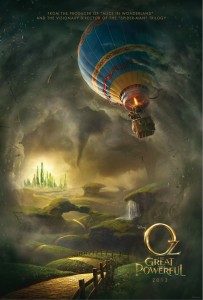 Who knew the wonderful wizard of Oz was such an incorrigible poon-hound? And who knew the magical land of Oz is the perfect place to have a journey that teaches one the values of monogamous commitment, and mythologizes the creation of an artificial God?
Who knew the wonderful wizard of Oz was such an incorrigible poon-hound? And who knew the magical land of Oz is the perfect place to have a journey that teaches one the values of monogamous commitment, and mythologizes the creation of an artificial God?
Disney did, that’s who.
Oz The Great And Powerful is a film forged in the same fires as the company’s 2010 hit fairy tale, Tim Burton’s Alice In Wonderland– the furnace now raging with the fuel of a billion of the world’s dollars. Fortunately for us, Sam Raimi’s film is much, much better than Burton’s Alice In Wonderland, and in and of itself manages to resemble something like a good blockbuster adventure movie. It’s not exactly –it does far too many dumb things and features too many laughable moments to be that– but it’s confidently entertaining and the very opposite of dull. The key ingredient here is Sam Raimi, as his sensibilities are all over this film, down to a script that ostensibly re-appropriates Raimi’s own Army Of Darkness. The Evil Dead and Spider-Man director’s filmmaking shines- his sensibilities bright enough that even the thick layer of Disney on top becomes permeable, Raimi’s quirks plainly bleeding through.
In fact, his glee at running with with a new franchise backed by a Disney budget and armed with new visual toys is evident from the first black & white frame. Right away Oscar Zoroaster is breathlessly established as a selfish, vaguely ambitious goofball with at least some amount of legitimate 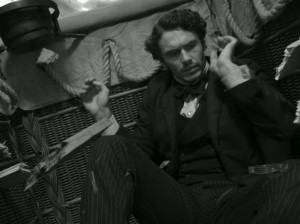 showmanship, and a long trail of lady’s broken hearts behind him. We see he has no appreciation for his friends, no fondness for the truth, and after a visit from a woman that would clearly be “the one” if he wasn’t so fixated on chasing skirt, Oz is off to the country that bears his name by way of a hot air balloon and a twister. We stick with this 4:3, desaturated view of the world just long enough to grow used to it before we enter Oz proper and the frame slowly opens up to the vividly saturated, Suessian landscape of Oz. Even having seen it a dozen times in the trailer, the aspect ratio shift is an effective moment.
showmanship, and a long trail of lady’s broken hearts behind him. We see he has no appreciation for his friends, no fondness for the truth, and after a visit from a woman that would clearly be “the one” if he wasn’t so fixated on chasing skirt, Oz is off to the country that bears his name by way of a hot air balloon and a twister. We stick with this 4:3, desaturated view of the world just long enough to grow used to it before we enter Oz proper and the frame slowly opens up to the vividly saturated, Suessian landscape of Oz. Even having seen it a dozen times in the trailer, the aspect ratio shift is an effective moment.
The story then turns into a journey of prophecy as Oz meets witches, partners up with a flying monkey and a porcelain girl, and struggles with the fact that he’s not actually a wizard as foretold by said prophecy. Good characters become bad, weak characters become strong, and the vague idea of “belief” (in whatever?) is touted as the key to pushing back darkness. This fantasy story is almost too straightforward to screw up, even if it can’t help but make dumb left turns that prevent characters from interacting for no good reason, other than it would hinder the plot from going where it’s designed to go. Even the grand twist of exactly which witch will make the switch into the iconic, hook-nosed broom-rider is played as no mystery at all. Surprisingly, the best part of the film is actually Oz’s time spent with his two CGI sidekicks, though that ends up being a relatively brief stretch.
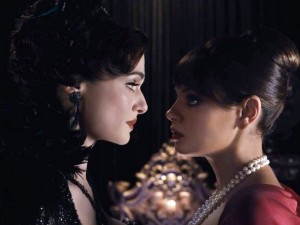 Throughout the journey we encounter new sections of Oz, from its Pandora-like jungles to the gothic Emerald City and cloud-filled skies that hang above them. Raimi’s visual approach is often bold and inventive, with plenty of 3D tricks and extravagant virtual camera moves that at least make the most of the all-CGI environments. His penchant for cartoonish violence is restrained but visible, and you can feel the director arm-wrestling Mickey Mouse for every frame of scariness he can pack in. A few slapstick beats between Franco and the forrest also recall Army Of Darkness, though capturing only a hint of that films fun.
Throughout the journey we encounter new sections of Oz, from its Pandora-like jungles to the gothic Emerald City and cloud-filled skies that hang above them. Raimi’s visual approach is often bold and inventive, with plenty of 3D tricks and extravagant virtual camera moves that at least make the most of the all-CGI environments. His penchant for cartoonish violence is restrained but visible, and you can feel the director arm-wrestling Mickey Mouse for every frame of scariness he can pack in. A few slapstick beats between Franco and the forrest also recall Army Of Darkness, though capturing only a hint of that films fun.
Since visual effects are such a huge part of this particular fantasy aesthetic, I’m pleased to say they are, mostly, wonderful. While there are plenty of actual objects and characters that stand out as CGI oddities, there other things like, say, the little porcelain girl that, at any given moment, I couldn’t tell you if I was watching a puppet or a CG element. Ultimately Raimi’s Oz itself is cohesive and sharp in all the ways Burton’s Wonderland is plastic and muted. Interiors in Oz are often lavish, physical sets that are a joy to look at, especially when they turn out to be more dimensional than the performances playing out within them.
It is in fact the performances that represent the most inconsistent characteristic of the film. Save for Rachel Weisz’s steady-as-she-goes coolness and Zach Braff’s child-pleasing sidekick work, all of the central performances are roller coaster rides of effectiveness and amateurishness. Michelle Williams, for example, barely keeps her attempt at a golden age performance on the rails. Tasked with the toughest role in the film, Mila Kunis swings wildly back and forth from laughable to compelling, with Raimi’s jarring cuts and odd angles rarely doing her any favors. In fact, from costuming to hair and make-up to the filmmaking aimed at her, it’s as if she manages a decent turn despite the entire production conspiring against her. Finally we land on James Franco, who often nails the cheesy grins and backpedalling buffoonery of a classic yellow-belly hero, but he just doesn’t have the command over the sum of his performance to sell the balance between kiddy humor and the very adult character arc they’re going for.
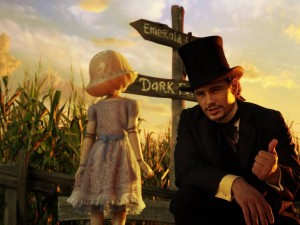
Spotty though the performances may be, it’s tough to aim too much of the blame at the actors themselves. They’re tasked with realizing a script bizarrely packed with adult themes that are so obliquely presented that in one or two places scenes just to run out of air because nobody can actually say what’s going on. The driving force of the film’s plot is Oz’s betrayals, but since nobody can come out and say, “that bastard banged my sister?!” it’s weirdly vague. Complicating matters even further is the bizarre sexual politics of the film, with a woman’s scorn becoming physical grotesqueness, or balance in the world seemingly only struck by the planting of a man’s ass on the throne. There is a reverence for a fallen patriarch who we’re told did good things, meanwhile the women left in charge are apparently capable of little more than in-fighting and hoping for a new hero. You can argue that Oz is merely an agent of a woman’s will, a catalyst for their insecurities and internal politics to play out, but the film’s grasp on such a dynamic is clumsy at best. Also, we never really figure out what the real bad guy is driving at, since nothing was really stopping her from conquering Oz, and she seems to have nothing more to gain!
Less troubling but equally weird are the religious implications of the film which, as you already well know, is about the establishment of an artificial God in order to drive darkness to the edges of Oz and reestablish order. When we see the familiar face of Oz in the smoke with all the fire and theatrics, it leaves you to wonder what Raimi and co. are saying about religious pageantry and worship. We watch an entire civilization essentially bow down in awe of a farce perpetrated by an outsider, after all. It’s rather shocking Disney signed off on such a script, even if I’m selfishly delighted they did so, just because it’s so weird.
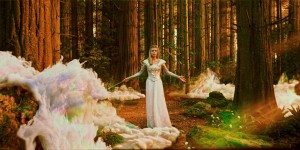
Ultimately there’s momentum and brightness enough that it’s quite disappointing when Oz The Great And Powerful stumbles at the finish. A rousing, well-executed finale brings a heist-like conclusion to the film’s great quest, though it soon seems as if we’re going to get a nice one-on-one magical combat sequence to punctuate the climax. Unfortunately what follows is a lame, insubstantial little battle that seems as much about setting up possible sequels as delivering actual excitement. The moment is there for some Voldemort V. Dumbledore-level combat sorcery, but whether it was Disney’s constitution or Raimi’s budget that gave out, it just doesn’t come.
It’s a strange Disney film that attempts to be a child-pleasing adventure, all while Mickey’s gloves burst from the screen to cover the kiddies’ ears so the film can quietly mouth the more mature ideas at the grown-ups. Mash that together with the God stuff and gender dynamics that are at best clunky, at worst regressive, and you have a rather messy fairy tale being bolted to a beloved classic. The film is beautiful, the filmmaking is energized, and the humor works, so Raimi’s latest blockbusters avoids outright disaster, but Oz The Great And Powerful is neither. Perhaps Oz The Pretty And Serviceable would be more appropriate.
Rating: 




Out of a Possible 5 Stars